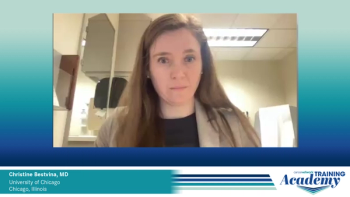
Sandip Patel, MD, presents a case study of a 62-year-old female patient with a PD-L1 expression of 60%, an EGFR exon 20 insertion mutation, and liver lesions, followed by a panel discussion on diagnostic strategies to optimize patient care.

Your AI-Trained Oncology Knowledge Connection!


Sandip Patel, MD, presents a case study of a 62-year-old female patient with a PD-L1 expression of 60%, an EGFR exon 20 insertion mutation, and liver lesions, followed by a panel discussion on diagnostic strategies to optimize patient care.

Christine Bestvina, MD, presents her treatment strategy for a 62-year-old female with NSCLC, bone and liver metastases, and an EGFR exon 20 insertion; the panel then assesses clinical data, including the MARIPOSA trial, to guide their treatment decisions.

The panelists explore the importance of communicating with patients, nurses, and caregivers about potential adverse reactions and injection site reactions, while emphasizing the need to offer ongoing reassurance and support throughout the treatment journey.

Alexander Spira, MD, PhD, FACP, presents a case of a 45-year-old male with stage IV NSCLC, bone and liver metastases, and an EGFR exon 20 insertion; the panel then discusses their approach to treating brain metastases using stereotactic radiosurgery radiation therapy.

Christine Bestvina, MD, presents a case of a 34-year-old non-smoker diagnosed with Stage IIIA NSCLC after presenting with chest wall pain; the panel then explores their approaches to managing toxicities, including rashes and sores, by employing dose reductions and steroids to control adverse reactions.

Estelamari Rodriguez, MD, MPH, presents a case of a 50-year-old African American woman, non-smoker, with pleural metastases; the panel discusses interstitial lung disease management, the use of antibody-drug conjugates, disease timing, and strategies for providing symptomatic relief, specifically considering drug holds if steroids only offer partial relief.

Medical experts explore the advantages and disadvantages of next-generation sequencing testing, highlighting the disparities in the quantity of tissue samples being sent for analysis, which can lead to inconclusive results when insufficient sample sizes are provided.

In their closing remarks, the panel reflects on the presented patient cases and shares insights on the future of non-small cell lung cancer (NSCLC) treatment.

During a Training Academy focused on first-line treatment use in non–small cell lung cancer, panelists discussed a patient case and how they would treat that patient in the setting.